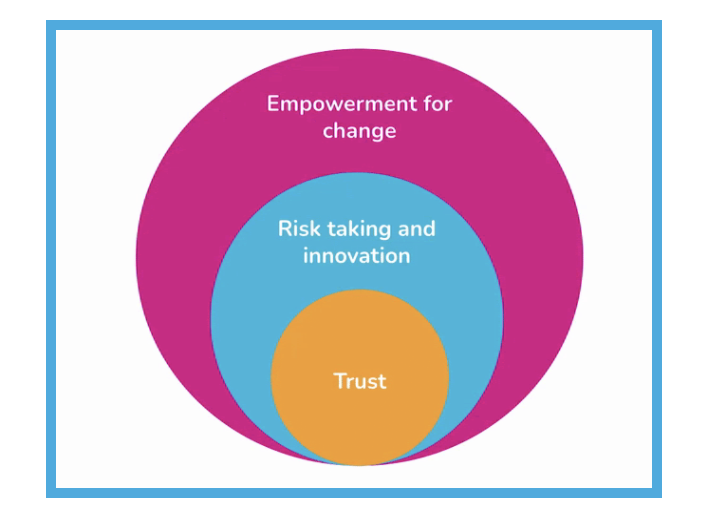Developing a Next Generation Approach to PD for Agency, Innovation, and Future-forward Classrooms
For the past year, I have worked with a group of bold and brave administrators to revolutionize how they support their staff as they work towards reimagining learning environments. Our objective was to personalize professional development with a focus on agency and culture in order to make that happen. The work we are doing together always brings me back to a quote by Antoine De Saint-Exupery, “If you want to build a ship, don’t drum up the men to gather wood, divide the work, and give orders...Instead, teach them to yearn for the vast and endless sea.”
What I’ve consistently seen working with school leaders across the country is that leaders who build a staff that “yearns for the vast and endless sea” fare far better during a “disruptive moment” in education. Those leaders use moments like these to pave the foundation for an even stronger culture and future.
In our last session of the year together, I presented the below graphic to this group of administrators. I explained that trust is the foundation for risk-taking and innovation, which then leads to long-term, sustained change in classrooms. Therefore, it’s imperative that we approach our leadership from the lens of building trust.

Trust is empowering, improves overall motivation, encourages collaboration, productivity, and most of all creates a strong culture. But what are the real structures that you and your leadership team can put into place to develop trust?
Below are tangible structures that I’ve coached school leaders to use with their teams that have helped to shift and sustain teams towards an empowered culture, including during one of the most challenging culture years we’ve all experienced. You can implement these same structures this school year as you formulate a plan on how to best support your staff.
1. Shift conversations from deficit thinking to a pedagogical problem-solver approach
At LINC we define a pedagogical problem solver as a teacher who is a reflective practitioner, nurtures student voice, studies student needs, employs various strategies, and continuously adjusts to meet learner needs. How can using this definition of teaching change how you coach your teachers? First, you may need to ask teachers to reflect on these questions:
- What is a problem of practice that I see inmy classroomaround supporting better outcomes for students?
- What blockers prevent that from existing in my classroom?
Be aware. Are the teacher named problems “kid centered” vs. “teacher centered”? For example, “students don’t want to talk in my class” is a kid centered problem. To reframe that problem, you might coach the teacher and ask, “what are the conditions that need to exist in your classroom for students to collaborate?"
2. Build intentional collaboration
Problems of practice should be examined through an inquiry lens. To do that, I suggest creating intentional collaboration structures. Here are a few examples:
- Create a problem of practice digital toolbox to determine what common problems of practice your teachers are dealing with.
- Create a shareable Google slide deck where teachers can show evidence of how they are addressing that common problem of practice (lesson plans, student examples, tech tools or other resources they are using, etc.).
- Use that toolbox to celebrate innovation and coach for further development.
- Shared reflection - use inter-classroom visitation protocols to create structures for shared reflection. The goal with shared reflection protocols is to bring teaching practices from individual classrooms into the school community.
- Set up aPineapple Chart system where teachers can indicate the class period when they are trying something new or showcasing a skill they have developed so that other teachers can come in to observe.
- Create “Innovator in Action” badges that teachers can put up on their classroom door. These badges allow teachers to showcase pedagogical practices or tech tools they are using. For example, if Mr. Morales is using Station Rotation in his Social Studies class, he would place a “Station Rotation” Innovator in Action badge outside his door. Putting up that badge lets other teachers know that he is someone who uses Station Rotation and can support other teachers in implementing that blended model.
3. Collect data about your culture and then follow through to take action
Do you have a real pulse of the culture in your school building? If not, here is something you can do at the start of the school year to better understand the culture in your school community.

- Conduct stay interviews - We’ve heard of exit interviews, but there’s incredible culture building power in one-on-one conversations around why staff members have decided to stay. Some example “stay interview” questions are:
- “What do you look forward to each day when you commute to work?”
- “Why do you stay here?”
- “What can I do to make your job better for you?”
- “What motivates (demotivates) you?”
At the beginning of the school year, it will be worth it to invest time in having these conversations with your staff. Not only does it give you valuable information about what drives each of your staff members, but it communicates your commitment to listening to and supporting your team.
After facilitating those conversations, make sure you have a plan to take action on the feedback: provide leadership or mentoring opportunities for your staff, celebrate your staff and “shout out” when staff are being innovative, taking risks, or supporting each other. I encourage you to be transparent about your decisions by calling out when you are making a change, explain the why, and name challenges.
As a leader, you can choose to implement all or some of these structures, but remember that your staff are the customers of your leadership. Please take a moment to reflect on your leadership: Are you transparent about your decisions? Do you model and celebrate a fail forward environment? Do you encourage your staff to take risks? Do you have structures in place to allow teachers to intentionally reflect and collaborate on their practice.
Let’s be leaders that provide the right supports for our staff to “yearn for the vast and endless sea” toward innovative future-forward classrooms. I would love to hear your thoughts and reflections on how we can continue to build a trusting and supportive culture in our schools. What’s working for you? Connect with me on Twitter @KateTechCoach or via email at kateschuster@linclearning.com.